OSC
This chapter describes the key features of the [OSC] menu, which manages OpenFrame OSC, in OpenFrame Manager.
1. Overview
[OSC] provides a set of management functions for regions and servers of the OSC system.
[OSC] consists of region and system level menus.
-
Region level menu items are used to manage a specific region and require the user to first select the node name of a region.
-
System level menu items are used to manage the overall OSC system.
The following are the steps for making a request to the server through [OSC].
-
Tmax TP-Call is issued to Tmax server to send the request to the server.
-
OSC system processes the request and issues TP-Call to the WAS (Web Application Server) to return the response data.
-
WAS returns the response data back via HTTP protocol and the result is displayed in the browser in HTML/JavaScript for the user.
Click [OSC] at the top, and then click a menu from the left navigation pane to access the OSC system.
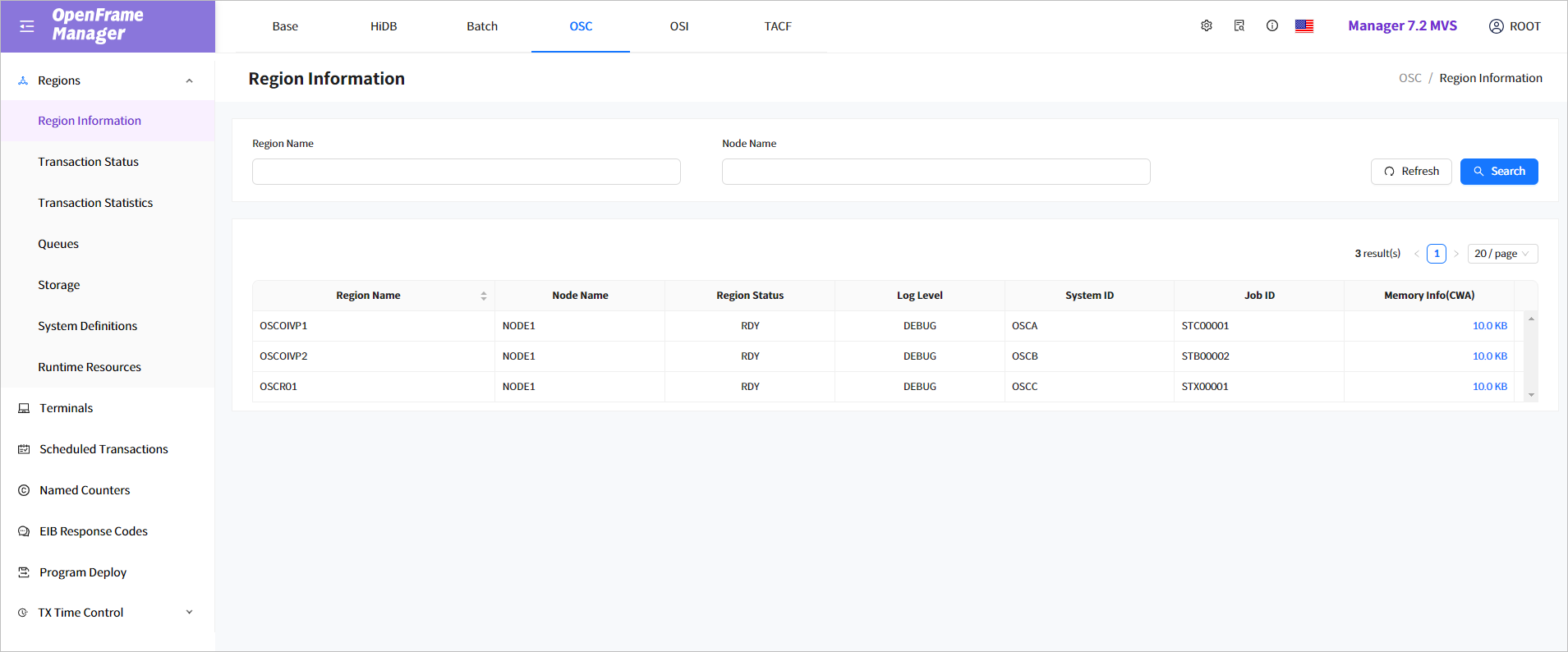
The following describes the menus in the navigation pane.
| Menu | Description |
|---|---|
Displays region information, transactions, transaction statistics, resources, and more.
|
|
Displays a list of terminals connected to GW and terminal related information. |
|
Displays and delete transactions scheduled via START or DELAY command. |
|
Displays a list of named counters. |
|
Displays help for CICS command response codes. |
|
Displays, adds, modifies, deletes, and deploys (oscrtsdupdate) programs for each region. |
|
Sets to test the entire OSC system or specific user programs at a specific time.
|
2. Regions
You can use the Regions menu to look up region information, transactions, transaction statistics, resources, and more. The following sections describe each submenus.
2.1. Region Information
Click [Regions] > [Region Information] from the navigation pane to display information about a region and access the CWA view of the region.

When a region server is in an abnormal state (Region Status is 'NRDY'), no data is shown in the CWA HEX/ASCII View.
-
Search Condition
The following describes the search conditions.
Item Description Region Name
Searches by entering a region name (Exact search method).
Node Name
Searches by entering a node name (Exact search method).
-
Region Info Search Items
Displays detailed information about the selected region.
Item Description Region Name
Region name.
Node Name
Node name of the region.
Region Status
Region state.
-
RDY: ready and waiting.
-
NRDY: in abnormal state.
Log Level
Log level of the region.
-
ERROR
-
INFO
-
DEBUG
-
TEST
System ID
System ID (SYSID) of the region.
Job ID
Job ID of the region.
Memory Info (CWA)
CWA (Common Work Area) size (shared memory size shown with unit). Click this to check the information in the CWA HEX/ASCII View. (refer to [OSC] - CWA HEX/ASCII View).
-
-
CWA Hex/ASCII View
CWA (Common Work Area) is the data area allocated for each OSC application server.
CWA is created when the OSC application server starts up and only persists while the system is running. It is used to share data between multiple programs or to send program execution results to another transaction or program. The data in the CWA can also be seen in Hex/ASCII view.
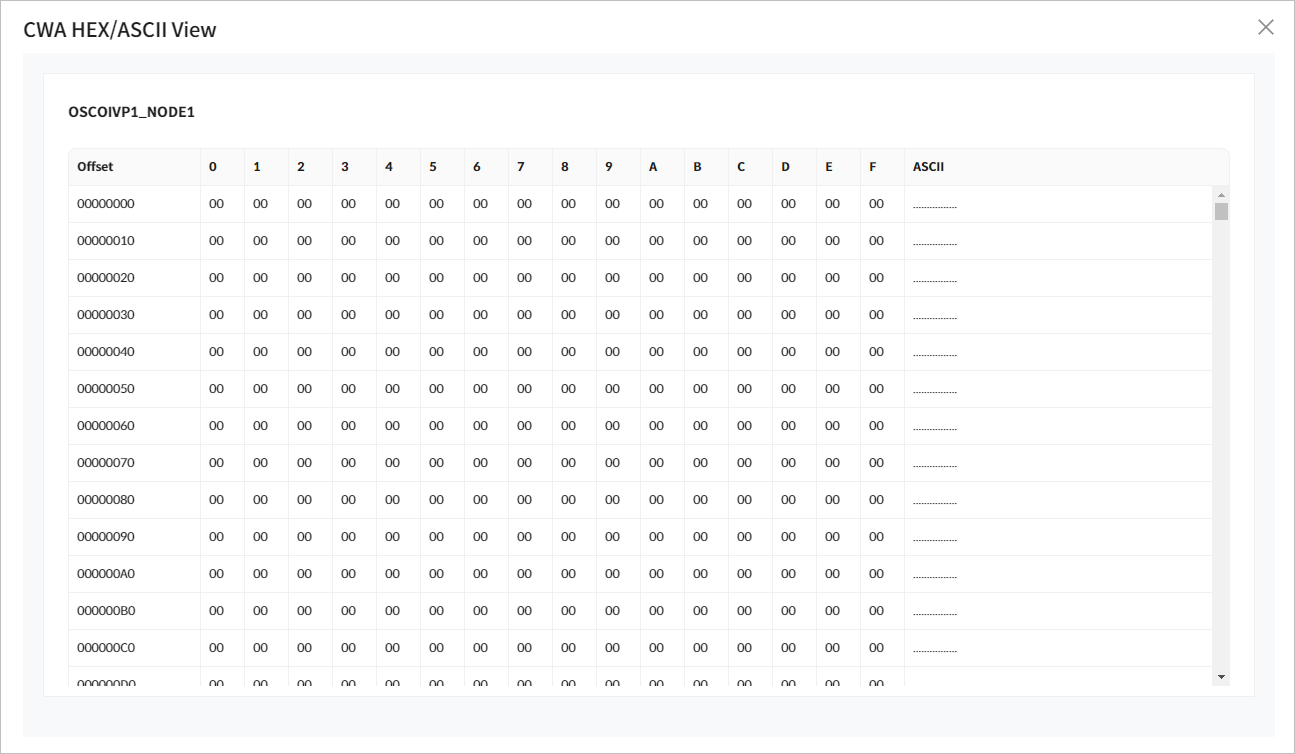 [OSC] - CWA HEX/ASCII View
[OSC] - CWA HEX/ASCII View
2.2. Transaction Status
Click [Regions] > [Transaction Status] from the navigation pane to go to the Transaction Status page. The user can view a list of region servers and their processes, and the transactions that each process is currently processing.
Click a node name from the Regions list (left tree view) to display its servers. Enter a server name in the Region Server Name field and then click [Search] to display the results. If no keyword is specified, all servers are displayed. Click [Refresh] above the list to refresh the list.
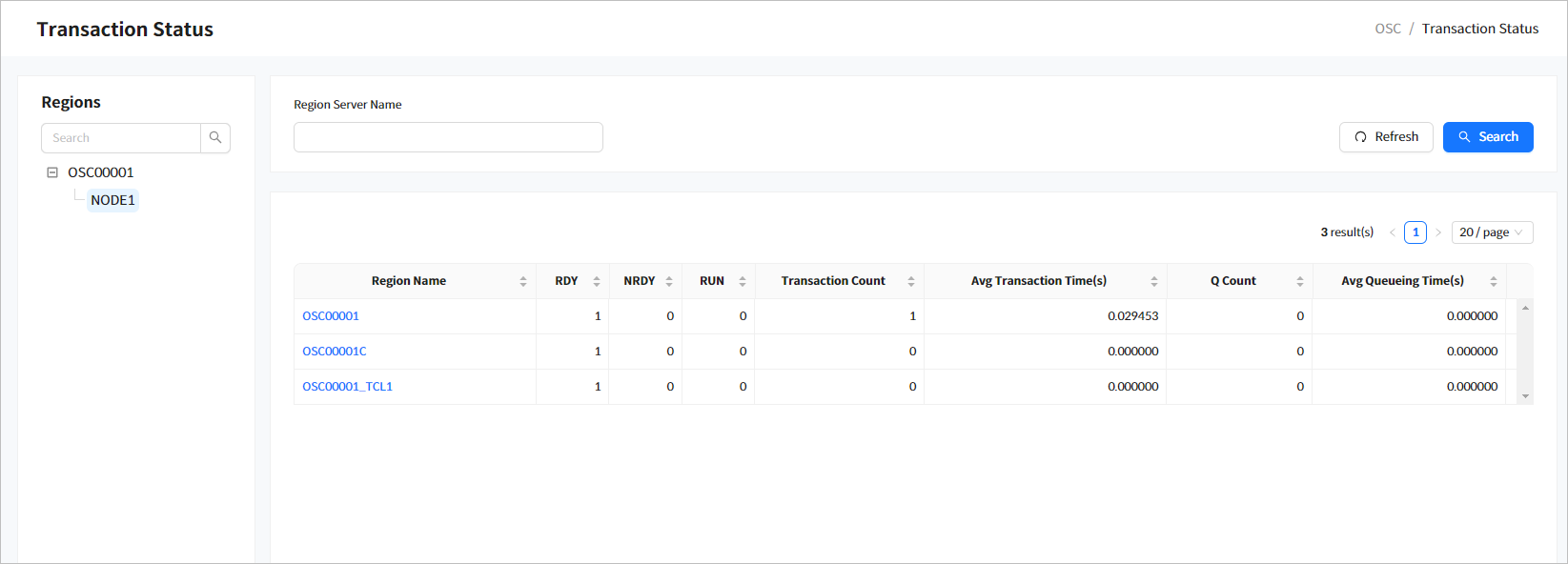
-
Search Results
The following describes the search result columns.
Column Description Region Name
List of region servers that are required in the region.
Click a server name to go to the Transaction Status Details page ([OSC] - Regions - Transaction Status - Transaction Status Details). For more information, refer to Transaction Status Details.
RDY
Number of region server processes in the Ready state.
NRDY
Number of region server processes in the Not Ready state.
RUN
Number of region server processes in the Run state.
Transaction Count
Number of transactions processed after the server starts.
Avg Transaction Time(s)
Average transaction execution time. (Unit: seconds)
Q Count
Number of queued transactions.
Avg Queuing Time(s)
Average queuing time for transactions. (Unit: seconds)
2.2.1. Transaction Status Details
Click a server name in the Region Name column in the Transaction Status page ([OSC] - Transaction Status) to go to the Transaction Status Details page. Click the [<] icon before the page title to return to the previous page.
To refresh the list, click [Refresh] above the list. To forcibly kill a server process, select it and then click [Kill].

-
Search Results
The following describes the search result columns.
Column Description SPRI (Server Process ID)
Tmax server process index number.
PID (Process ID)
Server process ID.
Status
Server status.
-
RDY: transaction is ready to be run.
-
NRDY: transaction cannot be started.
-
RUN: transaction is running.
Running Transaction
ID of the currently running transaction.
This is displayed as a link that opens the Running Transaction Information window ([OSC] - Regions - Transaction Status - Running Transaction Information). For more information, refer to Running Transaction Information.
Transaction Count
Total number of times transaction was executed.
Avg Transaction Time(s)
Average transaction execution time. (Unit: seconds)
-
2.2.2. Running Transaction Information
If there is a transaction currently running in the process, a link with the Transaction ID is displayed under the Running Transaction column. Click this link to open the Running Transaction Information window that shows the transaction details.
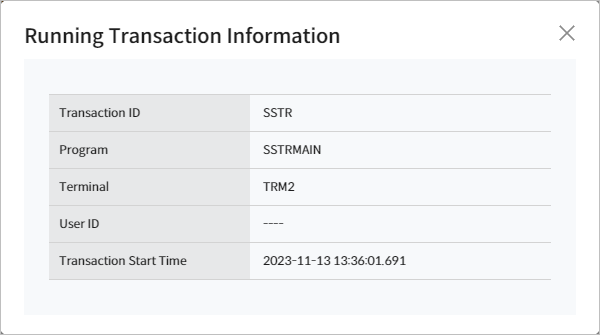
| Item | Description |
|---|---|
Transaction ID |
Transaction ID. |
Program |
Program initiated by the transaction. |
Terminal |
Terminal that is executing the transaction. |
User ID |
User ID that executed the transaction. |
Transaction Start Time |
Time when the transaction started in the form of 'yyyy-MM-dd hh:mm:ss.SSS' (SSS = milliseconds). |
2.3. Transaction Statistics
Click [Regions] > [Transaction Statistics] from the navigation pane to display statistics, such as USER TIME and CPU TIME, about completed transactions by date/time.
Select a region from the Regions list (left tree view). Enter the search conditions, and then click [Search] to display the results in the list. To refresh the list, click [Refresh] above the list.
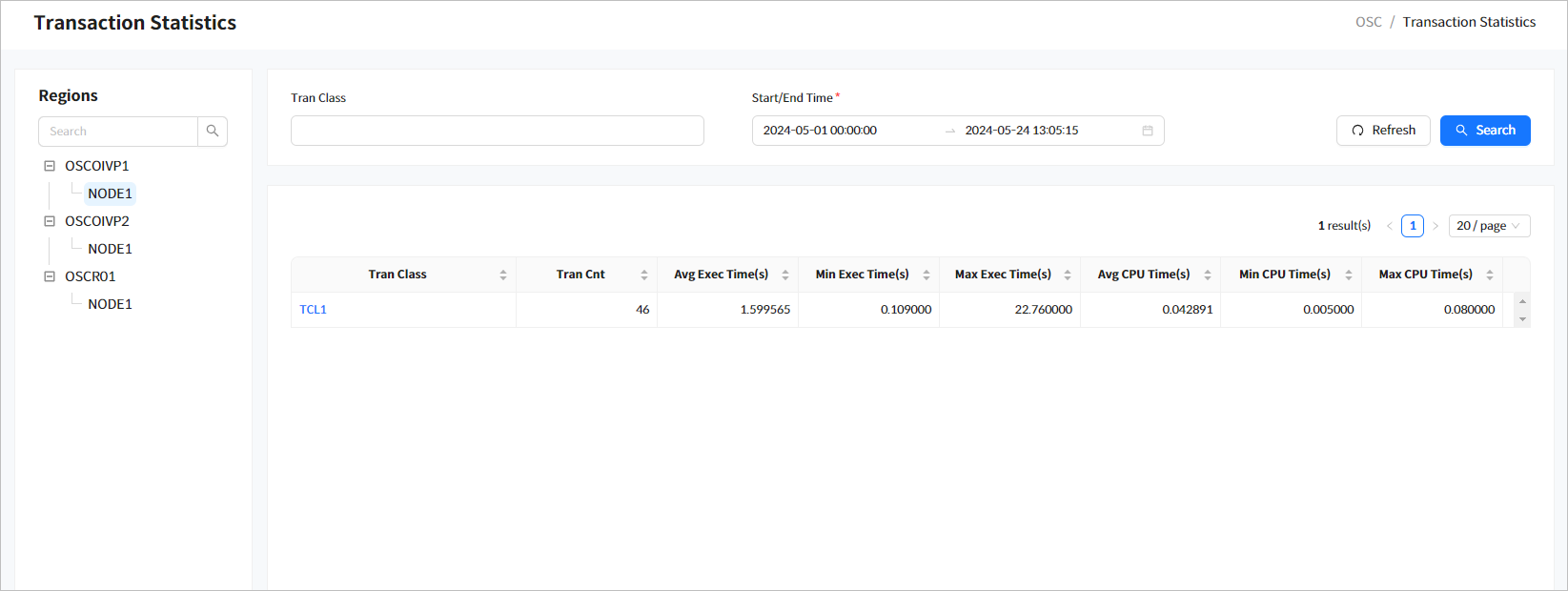
-
Search Conditions
The following describes the TranClass search conditions.
Item Description Tran Class
Transaction class name (Exact search method).
Start/End Time
Start/ End time for stats search.
Click the calendar icon to open the date picker control. Use the [▲] and [▼] buttons to increment the time by one second.
-
Search Results
The following describes the search result columns.
Column Description Tran Class
Transaction class name.
Click this to go to the Transaction Statistics Details page ([OSC] - Transaction Statistics Details) to display statistics for the transactions processed by the TranClass server. For more information, refer to Transaction Statistics Details.
Tran Cnt
Total number of times transaction was executed.
Avg Exec Time(s)
Average transaction execution time.
Min Exec Time(s)
Minimum transaction execution time.
Max Exec Time(s)
Maximum transaction execution time.
Avg CPU Time(s)
Average CPU time used for transaction processing.
Min CPU Time(s)
Minimum CPU time used for transaction processing.
Max CPU Time(s)
Maximum CPU time used for transaction processing.
2.3.1. Transaction Statistics Details
Click 'Tran Class' from the list in the Transaction Statistics page ([OSC] - Regions - Transaction Statistics) to display statistics for the transactions processed by the TranClass server. Click the [<] icon before the page title to return to the previous page. The search results are the same as the list mentioned above, but transaction names ('Transaction') is displayed instead of Tran Class names ('Tran Class') (Exact search method).
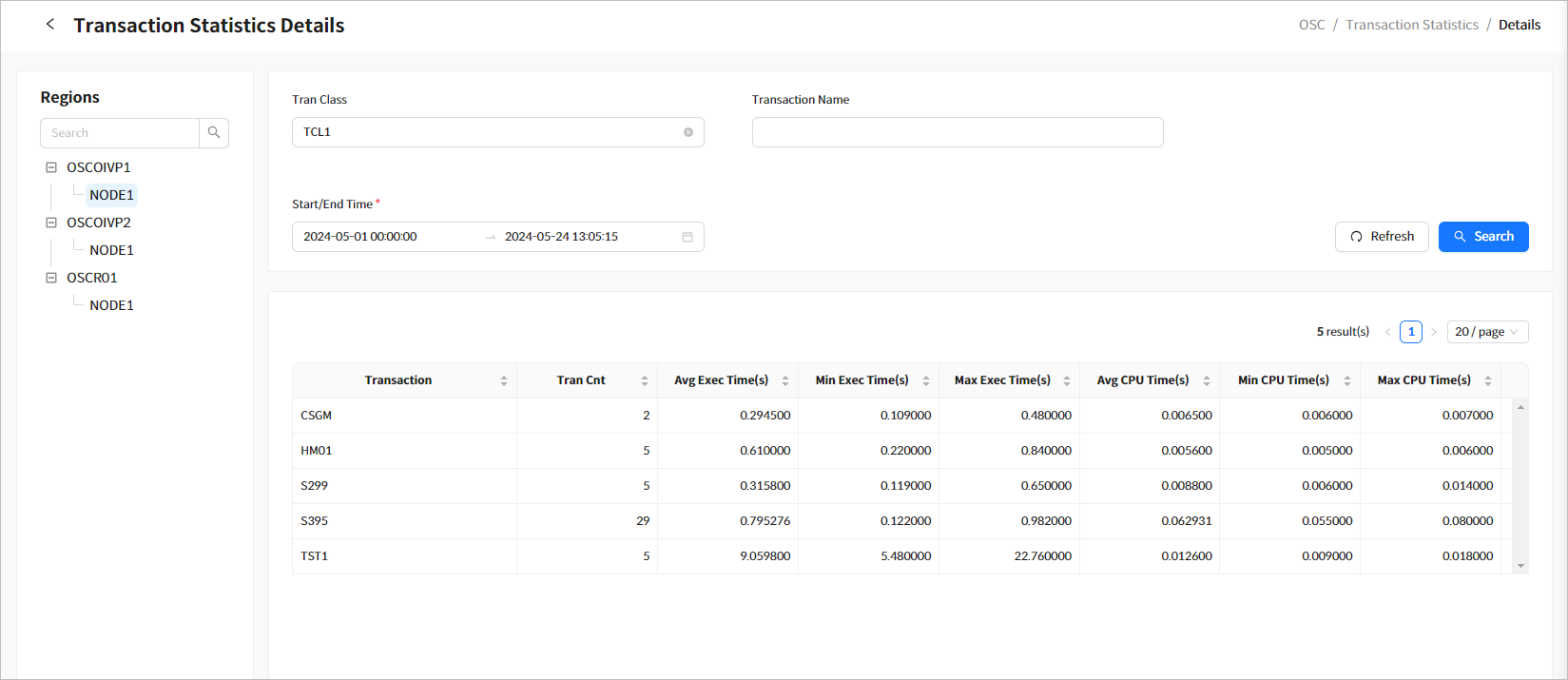
2.4. Queues
Click [Regions] > [Queues] from the navigation pane to go to the Queues page.
To search for a region, enter a region name from the tree view. Temporary Storage Queues (TSQ) and Transient Data Queues (TDQ) are displayed under the corresponding region. Enter the queue name in the 'TSQ Name' or 'TDQ Name' field, and then click [Search] to display the results. In case of TDQ, only INTRA TDQ can be retrieved. If no keyword is specified, all queue items are displayed. (LIKE (prefix) search method).
To refresh the list, click [Refresh] above the list. To delete a queue item, click [Delete] above the list.
Click a 'TSQ Name' or 'TDQ Name' item to view detailed queue information (see Queue Details).

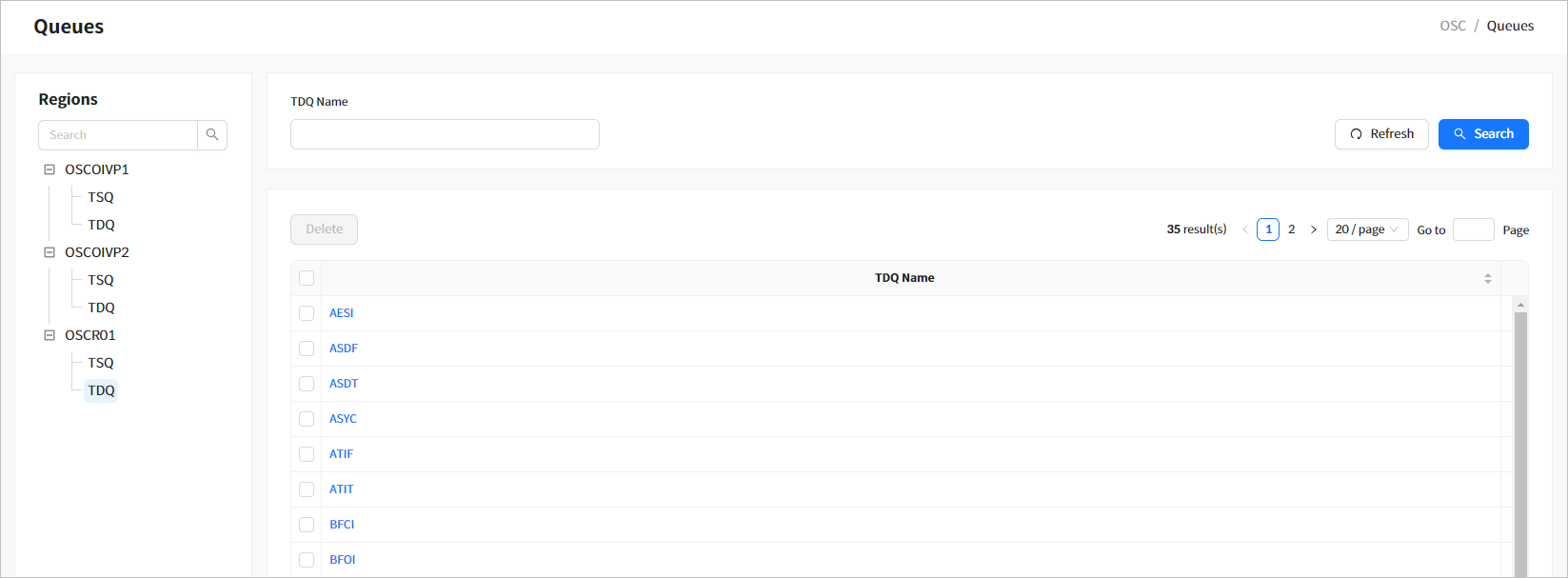
2.4.1. Queue Details
Click a 'TSQ Name' or 'TDQ Name' item from the list in the TSQ or TDQ ([OSC] - Regions - Queues (TSQ) or [OSC] - Regions - Queues (TDQ)) page to view detailed TSQ or TDQ information.
-
TSQ
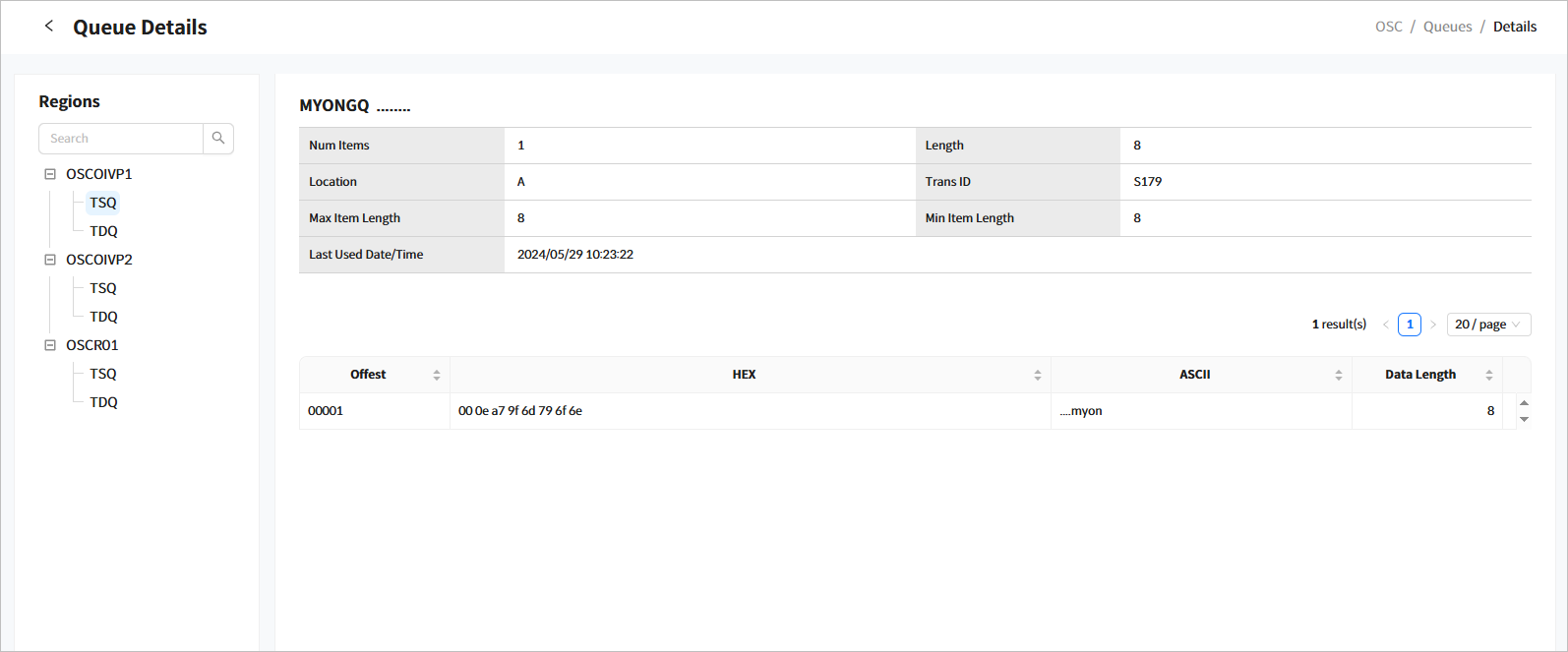 [OSC] - Regions - Queue Details (TSQ)
[OSC] - Regions - Queue Details (TSQ)The following describes the search result columns.
Column Description Num Items
Number of items in the queue.
Length
Total length of data in the queue.
Location
Location where the queue is located.
-
A: AUX which means a data set.
-
M: MAIN which means memory or a database table.
Trans ID
ID of the transaction that creates the queue.
Max Item Length
Length of the largest item data in the queue.
Min Item Length
Length of the smallest item data in the queue.
Last Used Date/Time
Most recent time to access the queue.
Offset
Offset of the item data.
HEX
Hexadecimal value of the item data.
ASCII
ASCII value of the item data.
Data Length
Length of the item data.
-
-
TDQ
 [OSC] - Regions - Queue Details (TDQ)
[OSC] - Regions - Queue Details (TDQ)The following describes the search result columns.
Column Description Offset
Offset of the item data.
HEX
Hexadecimal value of the item data.
ASCII
ASCII value of the item data.
Data Length
Length of the item data.
2.5. Storage
Click [Regions] > [Storage] from the navigation pane to display a list of memory areas occupied by OSC. Specify a memory area to be allocated to an application by using the OSC command (GEM MAIN) to display the memory information.
The Storage page consists of the Storage Info, Storage Search, and the Storages sections.
Select a node name from the Regions list (left tree view) to display the basic storage information and a list of storage addresses. Enter the search conditions and then click [Search] to display the results. If no conditions are specified, all storage addresses are displayed (LIKE (prefix) search method).
To refresh the list, click [Refresh] above the list.

-
Search Conditions
The following describes the storage search conditions.
Item Description Program
Program name.
Transaction ID
Transaction ID.
-
Storage Info
Displays the total storage space the can be allocated to application programs in the selected region.
Item Description Total
Total memory space.
Used
Total memory space in use. This is the sum of all sizes displayed in the Storage list. This includes the size of metadata (32 bytes) required to start a region.
-
Search Results
The following describes the search result columns.
Column Description Offset
Memory address allocated to the application program.
Transaction ID
Transaction ID.
Server Process ID
Server process index number issued by Tmax.
Program
Program name.
Size
Allocated memory size.
Allocation Date/Time
Date and Time of allocation.
2.6. System Definitions
Click [Regions] > [System Definitions] from the navigation pane to go to the System Definitions page.
The System Definitions page consists of the Groups list in the left pane and the System Definitions section for the selected group in the right pane.
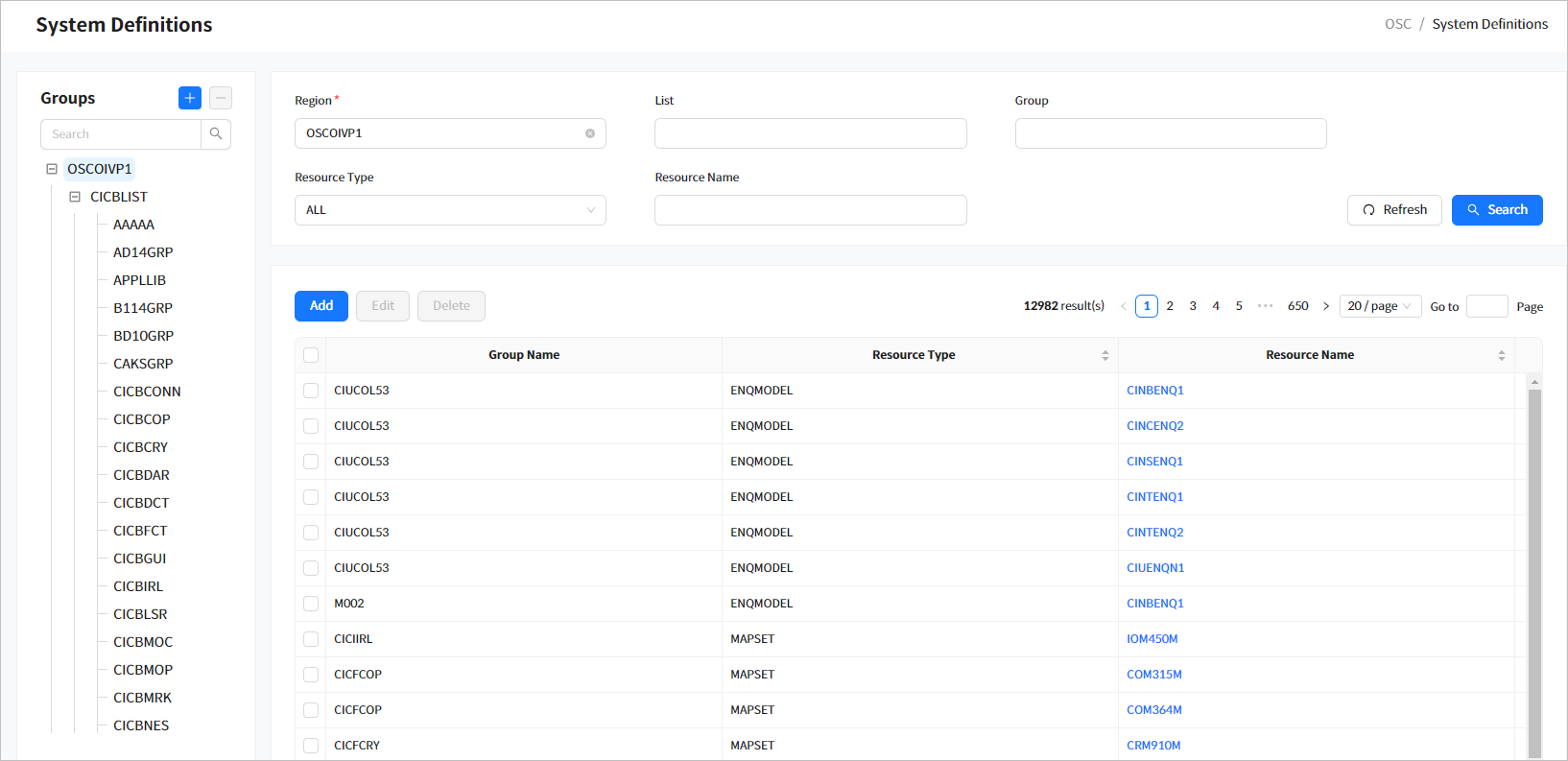
-
Groups
View, create, or delete a group.
Groups are displayed as a tree structure with hierarchy in the order of Region > List > Group. List is the GRPLIST value under the SD section in osc.{Region name} subject of the openframe_osc.conf file.
You can enter a group name in the search text box to search for a group, and use
 to add or
to add or  to delete a group. For more information about adding a group, refer to Managing Groups.
to delete a group. For more information about adding a group, refer to Managing Groups.For more information about openframe_osc.conf file, refer to OpenFrame Configuration Guide.
-
System Definitions Information
Check configuration of OSC resources by type and add, edit, and delete them. To add a resource, click [Add]. To edit it, click [Edit]. To delete it, click [Delete]. For more information, refer to Managing System Definitions.
Enter the search conditions, and then click [Search] to display the results. If no conditions are specified, all resources are displayed. To refresh the list, click [Refresh] above the list.
-
Search Conditions
The following describes the search conditions.
Item Description Region
Region (Exact search method).
List
List (Exact search method).
Group
Group (Exact search method).
Resource Type
Resource type. Select ALL to retrieve all resources.
Resource Name
Resource name (Exact search method).
-
Search Results
The following describes the search result columns.
Column Description Group Name
Group name of the resource.
Resource Type
Resource type.
Resource Name
Resource name.
-
2.6.1. Managing Groups
To add a new group, click ![]() above the Groups list in the System Definitions page ([OSC] - Regions - System Definitions) to go to the Add Group page. Enter the required fields, and then click [Add] to add the group or [Cancel] to cancel. The Groups list is refreshed to show the newly added group.
above the Groups list in the System Definitions page ([OSC] - Regions - System Definitions) to go to the Add Group page. Enter the required fields, and then click [Add] to add the group or [Cancel] to cancel. The Groups list is refreshed to show the newly added group.
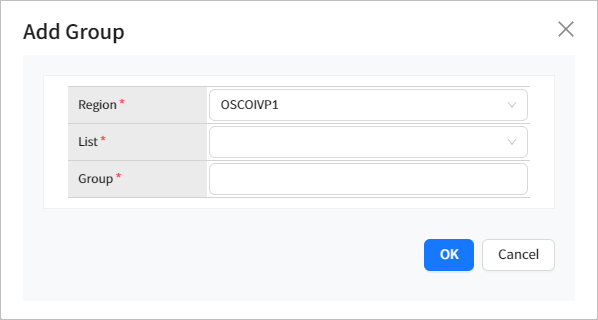
The following describes each item.
| Item | Description |
|---|---|
Region |
Region name to add the group to. The list of all running regions is displayed. |
List |
List name to add the group to. All lists of the region are displayed. An added group is displayed at the top of the tree view. |
Group |
Group name. Must be unique in the list. (Maximum 8 bytes) |
To delete a group, click ![]() above the Groups list in the System Definitions page ([OSC] - Regions - System Definitions). When the following dialog box is displayed, click [OK] to delete the group or [Cancel] to cancel. The Groups list is refreshed to reflect the change.
above the Groups list in the System Definitions page ([OSC] - Regions - System Definitions). When the following dialog box is displayed, click [OK] to delete the group or [Cancel] to cancel. The Groups list is refreshed to reflect the change.
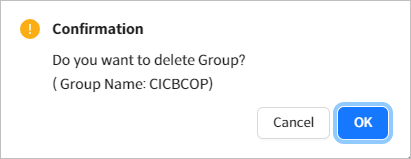
|
When deleting a group in which a resource exists, the resource cannot be linked with the LIST, so it cannot be used as a runtime resource of the region. |
2.6.2. Managing System Definitions
Click [Add] above the System Definitions list ([OSC] - Regions - System Definitions) to add a new resource. Enter the required fields, and then click [Add]. After a new resource is successfully created, the System Definitions list is refreshed to show the newly added resource. Click [Edit] to edit the resource. You cannot edit some fields, which can only be entered when adding the system definition.
You can add or edit system definitions of the following resource types. Refer to the description in each resource type section.
|
In addition to the above resource types, LIBRARY, ENQMODEL, WEBSERVICE, LSRPOOL, MAPSET, PIPELINE, PROFILE, and SESSIONS resources can be added, searched, edited, and deleted. However, Since OSC does not support the resource types, this guides does not cover them. For more information about resources, refer to OpenFrame OSC Resource Definition Guide. |
In this section, items are described in the Add page, and read-only items in the edit mode are separately indicated.
System Definition (CONNECTION)
The following is the page for defining a CONNECTION resource.

The following describes each item.
| Item | Description |
|---|---|
CONNECTION |
Connection name. Up to 4 bytes allowed. (Read-only in Edit mode) |
GROUP |
Group name of the resource. (Up to 8 bytes) (Read-only in Edit mode) |
NETNAME |
OSC server name to connect to. (Up to 8 bytes) |
PROTOCOL |
Connection protocol. (Currently only _blank is supported)
|
ACCESSMETHOD |
Access method for the connection. (Currently only VTAM is supported) |
INSERVICE |
Specifies whether the connection is available for use. |
System Definition (FILE)
The following is the page for defining a FILE resource.
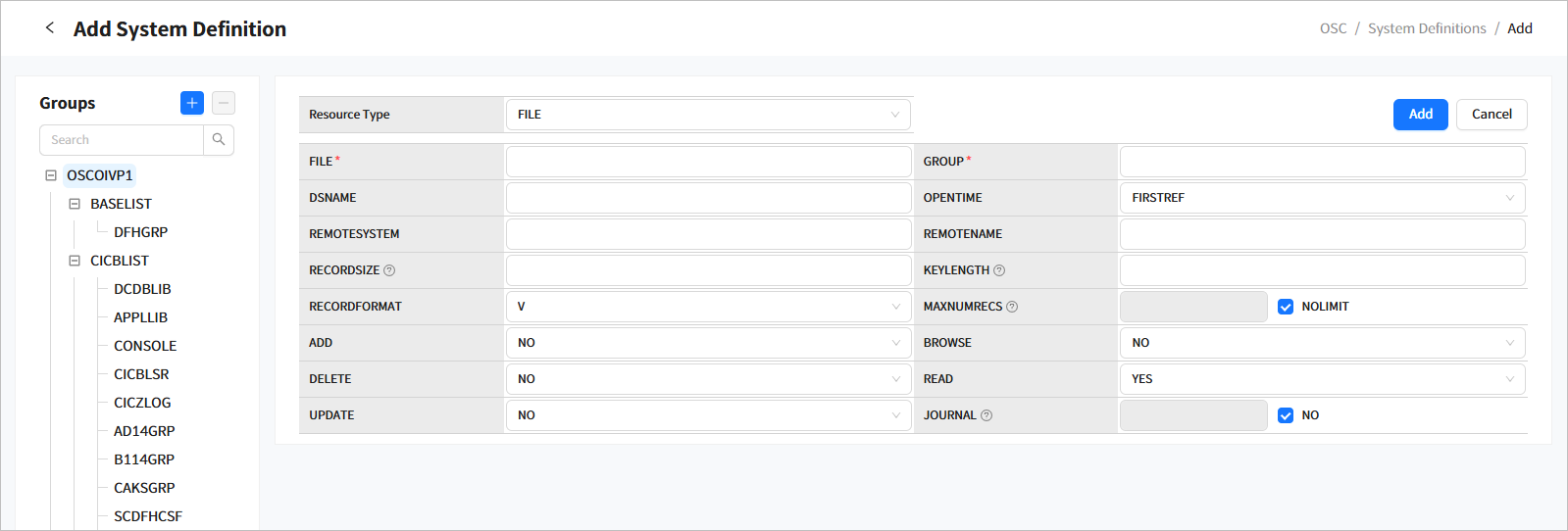
The following describes each item.
| Item | Description |
|---|---|
FILE |
File name. (Up to 8 bytes) (Read-only in Edit mode) |
GROUP |
Group name of the resource. (Up to 8 bytes) (Read-only in Edit mode) |
DSNAME |
Dataset name of the file. (Up to 44 bytes) |
OPENTIME |
Specifies when the file is opened by OSC engine for processing.
|
REMOTESYSTEM |
SYSID of the remote region server. (Up to 4 bytes) |
REMOTENAME |
File resource name used in the remote region server. (Up to 8 bytes) |
RECORDSIZE |
Maximum record length. |
KEYLENGTH |
Record key length. |
RECORDFORMAT |
Record format.
|
MAXNUMRECS |
Maximum number of records. |
ADD |
Option to enable adding new records to the file. (YES|NO) |
BROWSE |
Option to enable sequential search of records in the file. (YES|NO) |
DELETE |
Option to enable deleting records from the file. (YES|NO) |
READ |
Option to enable reading records from the file. (YES|NO) |
UPDATE |
Option to enable updating records in the file. (YES|NO) |
JOURNAL |
Journal name. Set to "No" to disable journaling. (Up to 8 bytes) If numbers between 1 and 99 are used for a journal name in an earlier version of CICS, change the format into DFHJnn for compatibility. (nn: a number between 1 and 99) |
System Definition (JOURNALMODEL)
The following is the page for defining a JOURNALMODEL resource.

The following describes each item.
| Item | Description |
|---|---|
JOURNALMODEL |
Journal model name. (Up to 8 bytes) (Read-only in Edit mode) |
GROUP |
Group name of the resource. (Up to 8 bytes) (Read-only in Edit mode) |
JOURNALNAME |
Journal name. (Up to 8 bytes) |
TYPE |
Target where the journal record will be output to.
|
STREAMNAME |
Name of the VB dataset that functions as LOG STREAM. |
System Definition (PROGRAM)
The following is the page for defining a PROGRAM resource.

The following describes each item.
| Item | Description |
|---|---|
PROGRAM |
Program name. (Up to 8 bytes) (Read-only in Edit mode) |
GROUP |
Group name of the resource. (Up to 8 bytes) (Read-only in Edit mode) |
LANGUAGE |
Programming language used to implement the program. (COBOL, PLI, or ASSEMBLY) |
RELOAD |
Option to use a copy when calling the program through LINK, LOAD, or XCTL. (YES|NO) |
RESIDENT |
Option to set residence state of the program. (YES|NO) |
TRANSID |
Transaction ID. (Up to 4 bytes) |
REMOTENAME |
Program name used by the remote region server. (Up to 8 bytes) |
REMOTESYSTEM |
SYSID of the remote region server. (Up to 4 bytes) |
System Definition (TDQUEUE)
The following is the page for defining a TDQUEUE resource.

The following describes each item. TDQUEUE has common items, and editable items for each type are different.
-
Common Items
The following describes common items.
Item Description TDQUEUE
TDQ name. (Up to 4 bytes) (Read-only in Edit mode)
GROUP
Group name of the resource. (Up to 8 bytes) (Read-only in Edit mode)
TYPE
TDQ type. (Required)
-
EXTRA: EXTRA-partition TDQ.
-
INDIRECT: INDIRECT TDQ.
-
INTRA: INTRA-partition TDQ.
-
LOG: LOG TDQ.
-
REMOTE: remote TDQ.
-
-
EXTRA TDQ
The following describes EXTRA TDQ items.
Item Description DDNAME
DD name specified in JCL. (Up to 8 bytes)
SYSOUTCLASS
SYSOUT dataset class name.
-
Character: single character (A-Z or 0-9).
-
Asterisk (*): default value.
-
blank: no input.
RECORDSIZE
Maximum record size. (Default value: 1)
-
If SYSOUTCLASS is specified, record size is 8,968 regardless of the record format.
-
If SYSOUTCLASS is not specified, record size is 32,767 regardless of the record format.
RECORDFORMAT
This must be set in conjunction with the Block Format item.
-
blank (Default value)
-
FIXED
-
VARIABLE
BLOCKSIZE
Maximum block size.
-
If SYSOUTCLASS is specified, block size is 8,972 for variable-length records and 8,968 for fixed-length records.
-
If SYSOUTCLASS is not specified, block size is 32,767 regardless of the block format.
BLOCKFORMAT
Block format.
-
blank
-
BLOCKED
-
UNBLOCKED
DISPOSITION
Dataset disposition.
-
SHR
-
OLD
-
MOD
TYPEFILE
Dataset type.
-
INPUT
-
OUTPUT
-
RDBACK
WRITER
WRITER name specified in JCL.
-
blank
-
INTRDR
PRINTCONTROL
Control character.
-
blank
-
ASA
-
MACHINE
ERROROPTION
Action to take when an I/O error occurs.
-
IGNORE
-
SKIP
OPENTIME
Initial state of the dataset.
-
INITIAL
-
DEFERRED
DSORG
DSORG name specified in JCL.
-
PS
-
DA
-
IS
-
PO
-
-
INDIRECT TDQ
The following describes INDIRECT TDQ items.
Item Description INDIRECTNAME
TDQ name to which the indirect queue points to. Use any TDQ types specified in INDIRECTNAME. (Up to 4 bytes)
-
INTRA TDQ
The following describes INTRA TDQ items.
Item Description ATIFACILITY
Facility to which transaction output is sent when an Automatic Transaction Initiation (ATI) occurs.
-
TERMINAL: output the terminal.
-
FILE: output to a file.
-
SYSTEM: transaction is not executed.
RECOVSTATUS
Recovery status.
-
NO: recovery is not performed.
-
PHYSICAL: physical recovery.
-
LOGICAL: logical recovery.
FACILITYID
Facility ID when ATI FACILITY is set to TERMINAL. If ATI FACILITY is set to FILE, this is set to blank.
TRANSID
Transaction ID that is initiated by ATI.
Trigger Level
Number of records in TDQ that triggers an ATI. (Maximum value: 32,767)
USERID
User ID used for security checking when verifying the value set in the Transaction ID field.
WAIT
Waits to commit changes based on UOW. (unsupported in OSC)
WAITACTION
Action to take for UOW. (unsupported in OSC)
Since Wait and Wait Action are not supported in OSC 7, they have no meaning in OpenFrame Manager.
-
-
LOG TDQ
The following describes LOG TDQ items.
Item Description DDNAME
DD name specified in JCL. (Up to 8 bytes)
DISPOSITION
Dataset disposition.
-
SHR
-
OLD
-
MOD
TYPEFILE
Dataset type.
-
INPUT
-
OUTPUT
-
RDBACK
-
-
REMOTE TDQ
The following describes REMOTE TDQ items.
Item Description REMOTESYSTEM
SYSID of the remote region server. (Up to 4 bytes)
REMOTENAME
TDQ name used in the remote region server. (Up to 8 bytes)
System Definition (TERMINAL)
The following is the page for defining a TERMINAL resource.

The following describes each item.
| Item | Description |
|---|---|
TERMINAL |
Terminal name. (Up to 4 bytes) (Read-only in Edit mode) |
GROUP |
Group name of the resource. (Up to 8 bytes) (Read-only in Edit mode) |
TYPETERM |
TYPETERM name of the terminal. (Up to 8 bytes) |
NETNAME |
LU name of the terminal. Must be unique in an application server. (Up to 8 bytes) |
PRINTER |
Printer name. (Up to 4 bytes) |
PRINTERCOPY |
Specifies whether to accept a print request on the printer specified in the Printer item. If the printer is not available, the request is routed to the printer specified in the Alternative Printer item if the Alternative Printer Copy item is set to "YES".
|
ALTPRINTER |
Alternative printer name to use if the printer specified in the Printer item is not available. (Up to 4 bytes) |
ALTPRINTERCOPY |
Specifies whether to accept a print request on the printer specified in the Alternative Printer item.
|
INSERVICE |
Terminal service status.
|
System Definition (TRANCLASS)
The following is the page for defining a TRANCLASS resource.

The following describes each item.
| Item | Description |
|---|---|
TRANCLASS |
TRANCLASS name. (Up to 8 bytes) (Read-only in Edit mode) |
GROUP |
Group name of the resource. (Up to 8 bytes) (Read-only in Edit mode) |
MAXACTIVE |
Maximum allowed number of concurrent transactions. |
PURGETHRESH |
Maximum number of transactions that can be queued. Any transactions that exceed this limit will be responded with an error. Check the None checkbox to disable this function (no limit on the queue). |
System Definition (TRANSACTION)
The following is the page for defining a TRANSACTION resource.

The following describes each item.
| Item | Description |
|---|---|
TRANSACTION |
Transaction name. (Up to 8 bytes) (Read-only in Edit mode) |
GROUP |
Group name of the resource. (Up to 8 bytes) (Read-only in Edit mode) |
PROGRAM |
Program that sends the control information to OSC to execute the transaction. (Up to 8 bytes) |
RESSEC |
Option to perform security checks whenever the transaction tries to access resources.
|
SHUTDOWN |
Option to enable transaction executions during OSC shutdown. Such transactions must be specified in the Transaction List Table (XLT).
|
TRANCLASS |
TRANCLASS name. |
PROFILE |
Name of a profile specifying the processing options to be used with the terminal that initiated the transaction. |
TWASIZE |
TWA size. (Maximum value: 32,767) |
TASKREQ |
Specifies the method for initiating a transaction using one of the following:
|
STATUS |
Enables or disables the transaction. |
System Definition (TSMODEL)
The following is the page for defining a TSMODEL resource.

The following describes each item.
| Item | Description |
|---|---|
TSMODEL |
TSMODEL name. (Up to 8 bytes, read-only in Edit mode) |
GROUP |
Group name of the resource. (Up to 8 bytes, read-only in Edit mode) |
PREFIX |
Prefix of the TSQ that TSMODEL is applied to. (Up to 16 bytes) |
LOCATION |
Location of the TSQ that TSMODEL is applied to.
|
RECOVERY |
Option to perform recovery when an error occurs in the TSQ that TSMODEL is applied to. |
System Definition (TYPETERM)
The following is the page for defining a TYPETERM resource.
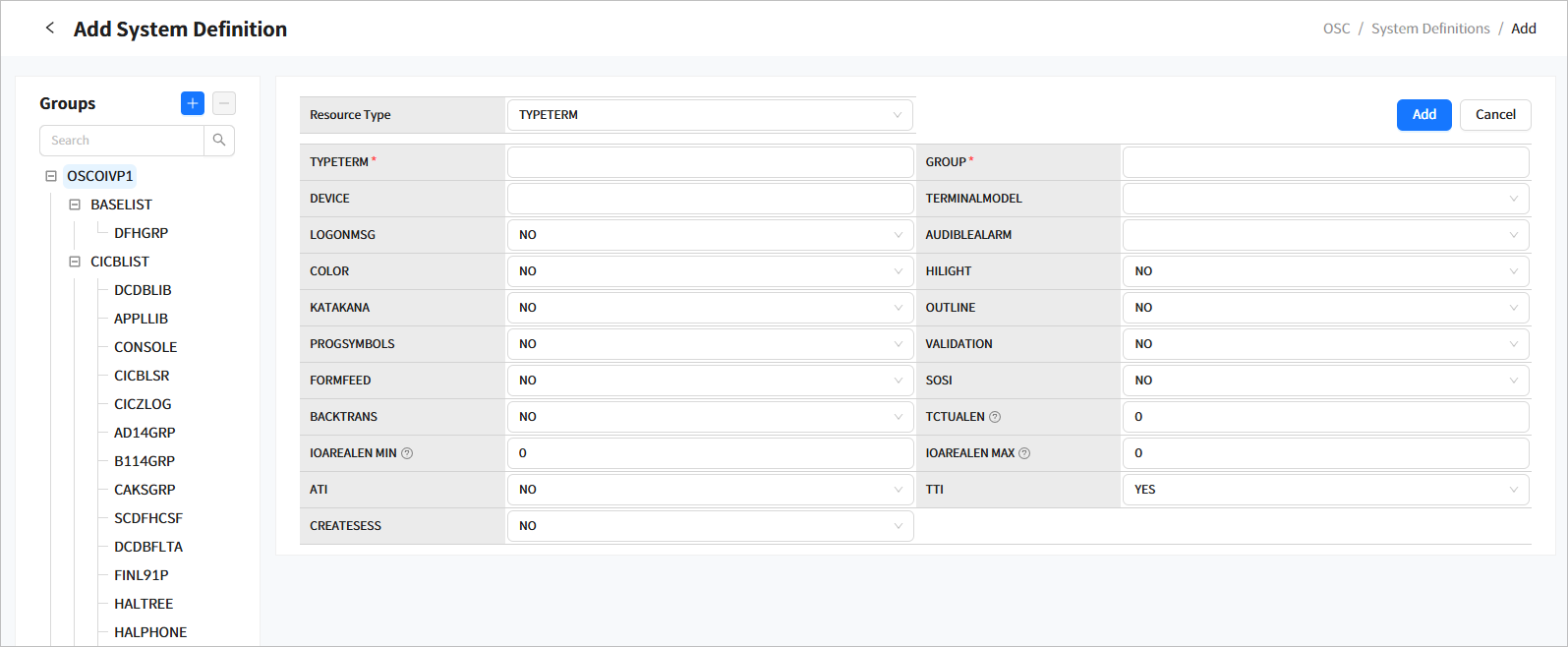
The following describes each item.
| Item | Description |
|---|---|
TYPETERM |
TYPETERM name. (Up to 8 bytes, read-only in Edit mode) |
GROUP |
Group name of the resource. (Up to 8 bytes, read-only in Edit mode) |
DEVICE |
Device type. |
TERMINALMODEL |
Terminal model number.
|
LOGONMSG |
Option to support "Good Morning" transaction. |
AUDIBLEALARM |
Option to enable audible alarm. |
COLOR |
Option to support extended colors. |
HILIGHT |
Option to support blink, underline, and reverse highlighting effects. |
KATAKANA |
Option to support Katakana characters. |
OUTLINE |
Option to support outlines. |
PROGSYMBOLS |
Option to support programmed symbol (PS) facility. |
VALIDATION |
Option to support field validation. |
FORMFEED |
Option to output FORMFEED characters for printer terminals. |
SOSI |
Option to support single and double byte characters. |
BACKTRANS |
Option to support screen background transparency. |
IOAREALEN MIN/MAX |
Minimum and maximum length of a terminal I/O area to be passed to a transaction. (Max value: 32,767) |
TCTUALEN |
Length of TCTUA area. (Default value: 0, Min value: 0, Max value: 32,767) |
ATI |
Option to allow START command or ATI request through TDQueue of an Intra-Partition to be executed through the terminal. (YES|NO, default value: NO) |
TTI |
Option to allow transactions to be initiated through the terminal. (YES|NO, default value: YES) |
CREATESESS |
Option to automatically connect to the region if an ATI request is received while the terminal is not connected to the region. (YES|NO, default value: NO) |
System Definition (URIMAP)
The following is the page for defining a URIMAP resource.
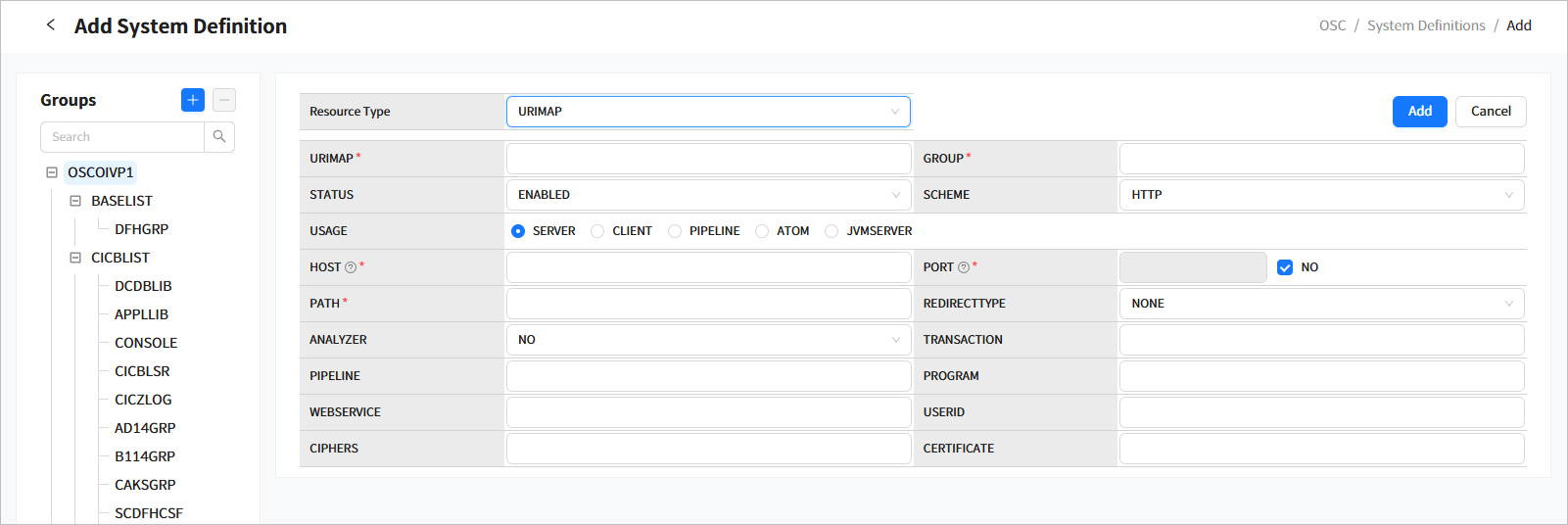
The following describes each item.
| Item | Description |
|---|---|
URIMAP |
URIMAP name. (Up to 8 byte, read-only in Edit mode) |
GROUP |
Resource definition group. (Up to 8 byte, read-only in Edit mode) |
STATUS |
Enables or disables URIMAP definition. (ENABLED|DISABLED) |
SCHEME |
Either HTTP or HTTPS. Specify HTTP for OSC. |
USAGE |
Option to use OSC as either a web server or a web client. (SERVER|CLIENT) |
PATH |
Path used to send or receive requests. |
|
Since items that are not described in the above table are not supported in OSC 7, they have no meaning in OpenFrame Manager. |
System Definition (TCPIPSERVICE)
The following is the page for defining a TCPIPSERVICE resource.
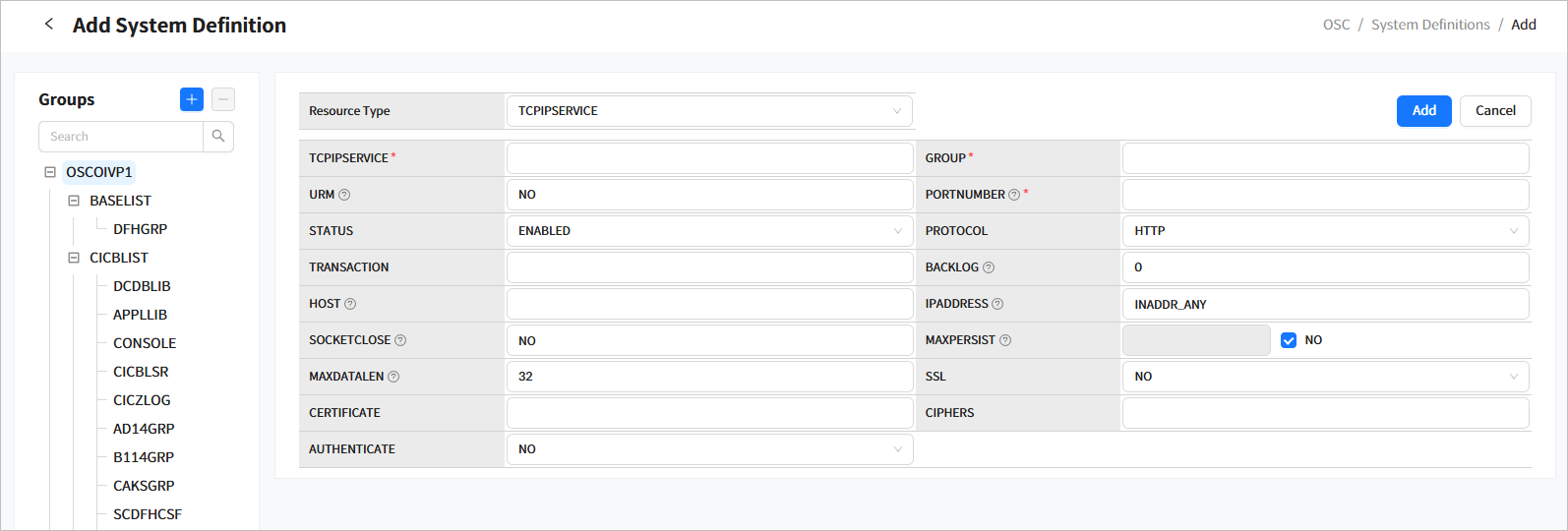
The following describes each item.
| Item | Description |
|---|---|
TCPIPSERVICE |
TCPIPSERVICE name. (Up to 8 bytes, read-only in Edit mode) |
GROUP |
Resource definition group. (Up to 8 byte, read-only in Edit mode) |
URM |
ANALYZER program. |
PORTNUMBER |
Port number used to receive requests. |
STATUS |
Option to receive requests. |
PROTOCOL |
Only HTTP is supported in OSC. |
TRANSACTION |
Name of the transaction to be executed as an alias transaction. (Default value: CWBA) |
|
Since items that are not described in the above table are not supported in OSC 7, they have no meaning in OpenFrame Manager. |
2.7. Runtime Resources
Click [Regions] > [Runtime Resources] from the navigation pane to go to the Runtime Resources page. The user can view, edit, and delete runtime resources by type.
Click a region from the Regions list (left tree view) and select a resource type from the Resource Type dropdown list and then click [Search]. The region will be started and the Runtime Resources list will be populated with runtime resources managed by the RTSD (Run-Time System Definition) (LIKE (prefix) search method).
Click [Refresh] to refresh the list.
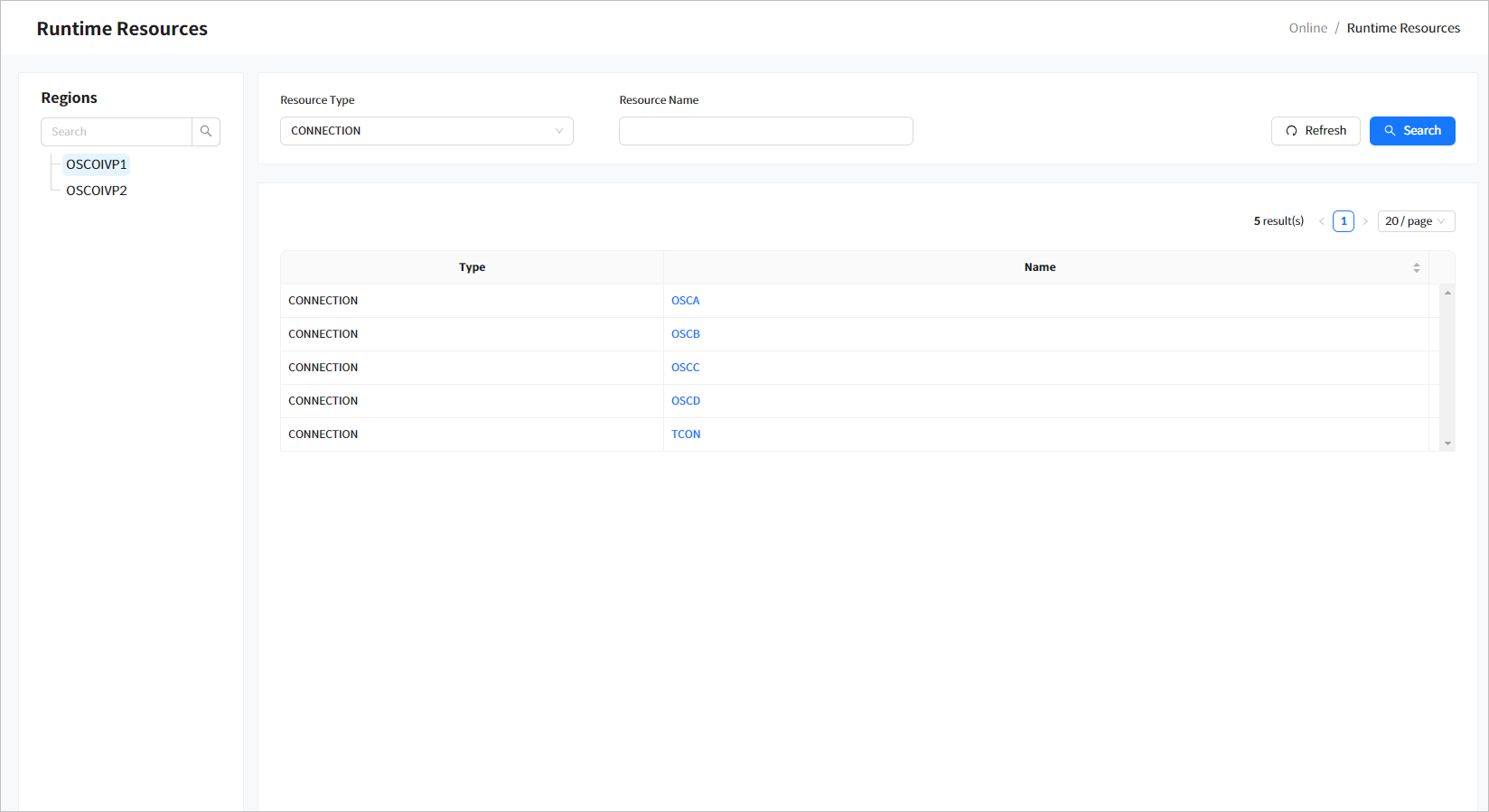
-
Search Conditions
The following describes the search conditions.
Item Description Resource Type
Resource type.
Resource Name
Resource name. (LIKE (prefix) search method)
-
Search Results
The following describes the search result columns.
Column Description Type
Resource type.
Name
Resource name. Click this to go to the runtime resource details page. For more information, refer to Managing Runtime Resources.
2.7.1. Managing Runtime Resources
Click a Name from the Runtime Resources list in the Runtime Resources page ([OSC] - Regions - Runtime Resources) to go to the Runtime Resource Details page for the corresponding resource type.
Click [Edit] to edit or [Delete] to delete a resource. When editing, only some fields are enabled for editing. When you click [Delete], a delete confirmation window is displayed. Click [OK] to delete the resource.
You can search the following resource types. Refer to the description in each resource type section.
In this section, items are described in the Runtime Resources page, and updatable items in the edit mode are separately indicated.
Runtime Resource (CONNECTION)
The following page shows the details of a CONNECTION resource.

| Item | Description |
|---|---|
CONNECTION |
Connection name. |
NETNAME |
OSC server name to connect to. |
PROTOCOL |
Connection protocol. (Currently only blank is supported)
|
ACCESSMETHOD |
Access method for the connection. (Currently only VTAM is supported)
|
INSERVICE |
Option to use the connection. (Updatable in Edit mode) |
Runtime Resource (FILE)
The following page shows the details of a FILE resource.

| Item | Description |
|---|---|
FILE |
File name. |
DSNAME |
Dataset name of the file. |
OPENTIME |
Specifies when the file is opened by OSC engine for processing.
|
REMOTESYSTEM |
SYSID of the remote region server. |
REMOTENAME |
File name in the remote region server. |
RECORDSIZE |
Maximum record length. |
KEYLENGTH |
Record key length. |
RECORDFORMAT |
Record format.
|
MAXNUMRECS |
Maximum number of records. |
ADD |
Option to enable adding new records to the file. |
BROWSE |
Option to enable sequential search of records in the file. |
DELETE |
Option to enable deleting records from the file. |
READ |
Option to enable reading records from the file. |
UPDATE |
Option to enable updating records in the file. |
JOURNAL |
Journal name. Earlier version of CICS used numbers between 1 and 99 for a journal name. For compatibility, the new format is DFHJnn. (nn: a number between 1 and 99) |
ENABLE STATUS |
File access.
|
OPEN STATUS |
File status.
|
Runtime Resource (JOURNALMODEL)
The following page shows the details of a JOURNALMODEL resource. This page is read-only.

| Item | Description |
|---|---|
JOURNALMODEL |
Journal model name. |
JOURNALNAME |
Journal name. Earlier version of CICS used numbers between 1 and 99 for a journal name. For compatibility, the new format is DFHJnn. (nn: a number between 1 and 99) |
TYPE |
Target where the journal record will be output to.
|
STREAMNAME |
Name of the VB dataset that functions as LOG STREAM. |
Runtime Resource (PROGRAM)
The following page shows the details of a PROGRAM resource.

| Item | Description |
|---|---|
PROGRAM |
Program name. |
LANGUAGE |
Programming language used to implement the program.
|
STATUS |
Program status. (Updatable in Edit mode)
|
RELOAD |
Option to use a copy when calling the program through LINK, LOAD, or XCTL. (YES|NO) |
RESIDENT |
Option to set residence state of the program. (YES|NO) |
REMOTESYSTEM |
SYSID of the remote region server. |
REMOTENAME |
Program name in the remote region server. |
TRANSID |
Transaction ID. |
Runtime Resource (TDQUEUE)
The following page shows the details of a TDQUEUE resource.

-
Common Items
The following describes each item.
Item Description TDQUEUE
TDQ name.
TYPE
TDQ type. (Required)
-
EXTRA: EXTRA-partition TDQ.
-
INDIRECT: INDIRECT TDQ.
-
INTRA: INTRA-partition TDQ.
-
LOG: LOG TDQ.
-
REMOTE: remote TDQ.
OPEN STATUS
TDQ status. (Extra TDQ is updatable in Edit mode)
-
OPEN: TDQ is open.
-
CLOSED: TDQ is closed.
ENABLE STATUS
TDQ access. (Extra TDQ is updatable in Edit mode)
-
ENABLED: access is enabled.
-
DISABLED: access is disabled.
-
-
EXTRA TDQ
The following describes EXTRA TDQ items.
Item Description DDNAME
DD name specified in JCL.
SYSOUTCLASS
SYSOUT dataset class name.
-
Character: single character (A-Z or 0-9).
-
Asterisk (*): default value.
-
blank: no input.
RECORDSIZE
Maximum record size. (Default value: 1)
-
If SYSOUTCLASS is specified, record size is 8,968 regardless of the record format.
-
If SYSOUTCLASS is not specified, record size is 32,767 regardless of the record format.
RECORDFORMAT
This must be set in conjunction with the Block Format item.
-
blank (Default value)
-
FIXED
-
VARIABLE
BLOCKSIZE
Maximum block size.
-
If SYSOUTCLASS is specified, block size is 8,972 for variable-length records and 8,968 for fixed-length records.
-
If SYSOUTCLASS is not specified, block size is 32,767 regardless of the block format.
BLOCKFORMAT
Block format.
-
blank
-
BLOCKED
-
UNBLOCKED
DISPOSITION
Dataset disposition.
-
SHR
-
OLD
-
MOD
TYPEFILE
Dataset type.
-
INPUT
-
OUTPUT
-
RDBACK
WRITER
WRITER name specified in JCL.
-
blank
-
INTRDR
PRINTCONTROL
Control character.
-
blank
-
ASA
-
MACHINE
DSORG
DSORG name specified in JCL.
-
PS
-
DA
-
IS
-
PO
-
-
INDIRECT TDQ
The following describes INDIRECT TDQ items.
Item Description INDIRECTNAME
TDQ name to which the indirect queue points to.
Use any TDQ types specified in INDIRECTNAME.
-
INTRA TDQ
The following describes INTRA TDQ items.
Item Description ATIFACILITY
Facility to which transaction output is sent when an Automatic Transaction Initiation (ATI) occurs.
-
TERMINAL: output to a terminal.
-
FILE: output to a file.
-
SYSTEM: transaction is not executed.
RECOVSTATUS
Recovery status.
-
NO: recovery is not performed.
-
PHYSICAL: physical recovery.
-
LOGICAL: logical recovery.
FACILITYID
Facility ID when ATI FACILITY is set to TERMINAL. If ATI FACILITY is set to FILE, this is set to blank.
TRANSID
Transaction ID that is initiated by ATI.
TRIGGERLEVEL
Number of records in TDQ that triggers an ATI. (Maximum value: 32,767)
USERID
User ID used for security checking when verifying the value set in the Transaction ID field.
Since WAIT and WAITACTION are not supported in OSC 7, they have no meaning in OpenFrame Manager.
-
-
LOG TDQ
The following describes LOG TDQ items.
Item Description DDNAME
DD name specified in JCL.
DISPOSITION
Dataset disposition.
-
SHR
-
OLD
-
MOD
TYPEFILE
Dataset type.
-
INPUT
-
OUTPUT
-
RDBACK
-
-
REMOTE TDQ
The following describes REMOTE TDQ items.
Item Description REMOTENAME
TDQ name in the remote region server.
REMOTESYSTEM
SYSID of the remote region server.
Runtime Resource (TERMINAL)
The following page shows the details of a TERMINAL resource.

| Item | Description |
|---|---|
TERMINAL |
Terminal name. |
NETNAME |
LU name of the terminal. |
TYPETERM |
TYPETERM name of the terminal. |
PRINTER |
Printer name. |
PRINTERCOPY |
Specifies whether to accept a print request on the printer specified in the Printer item. If the printer is not available, the request is routed to the printer specified in the Alternative Printer item if the Alternative Printer Copy item is set to "YES".
|
ALTPRINTER |
Alternative printer name to use if the printer specified in the Printer item is not available. |
ALTPRINTERCOPY |
Specifies whether to accept a print request on the printer specified in the Alternative Printer item.
|
INSERVICE |
Terminal service status. (Updatable in Edit mode)
|
DEVICE |
Device type. |
COLOR |
Option to support extended colors. |
ATI |
Option to allow START command or ATI request through TDQueue of an Intra-Partition to be executed through the terminal. (YES|NO) (Updatable in Edit mode) |
TTI |
Option to allow transactions to be initiated through the terminal. (YES|NO) (Updatable in Edit mode) |
CREATESESS |
Option to automatically connect to the region if an ATI request is received while the terminal is not connected to the region. (YES|NO) (Updatable in Edit mode) |
Runtime Resource (TRANCLASS)
The following page shows the details of a TRANCLASS resource. This page is read-only.

| Item | Description |
|---|---|
TRANCLASS |
TRANCLASS name. |
MAXACTIVE |
Maximum allowed number of concurrent transactions. |
PURGETHRESH |
Maximum number of transactions that can be queued. |
Runtime Resource (TRANSACTION)
The following page shows the details of a TRANSACTION resource.

| Item | Description |
|---|---|
TRANSACTION |
Transaction name or ID. |
PROGRAM |
Program that sends the control information to OSC to execute the transaction. |
RESSEC |
Option to perform security checks whenever the transaction tries to access resources.
|
SHUTDOWN |
Option to enable transaction executions during OSC shutdown. Such transactions must be specified in the XLT (Transaction List Table).
|
TRANCLASS |
Name of the TRANCLASS server where the transaction is processed. (Updatable in Edit mode) |
TWASIZE |
TWA size. (Maximum value: 32,767) |
STATUS |
Transaction status. (Updatable in Edit mode) |
Runtime Resource (TSMODEL)
The following page shows the details of a TSMODEL resource. This page is read-only.

| Item | Description |
|---|---|
TSMODEL |
TSMODEL name. |
PREFIX |
Prefix of the TSQ that TSMODEL is applied to. |
LOCATION |
Location of the TSQ that TSMODEL is applied to.
|
RECOVERY |
Option to perform recovery when an error occurs in the TSQ that TSMODEL resource properties are applied to. |
SECURITY |
Option to perform security checks on the TSQ that TSMODEL resource properties are applied to. (YES|NO) |
REMOTESYSTEM |
SYSID of the remote region server. |
3. Terminals
Click [Terminals] from the navigation pane to display a list of terminals connected through the selected OpenFrame Gateway.
Gateways are displays in a tree form in the left pane. Select a gateway from the tree to display the terminals connected through the gateway at the right. Click [Refresh] to refresh the Terminals list. Click [Disconnect] to forcibly end the connection between a terminal and a gateway.
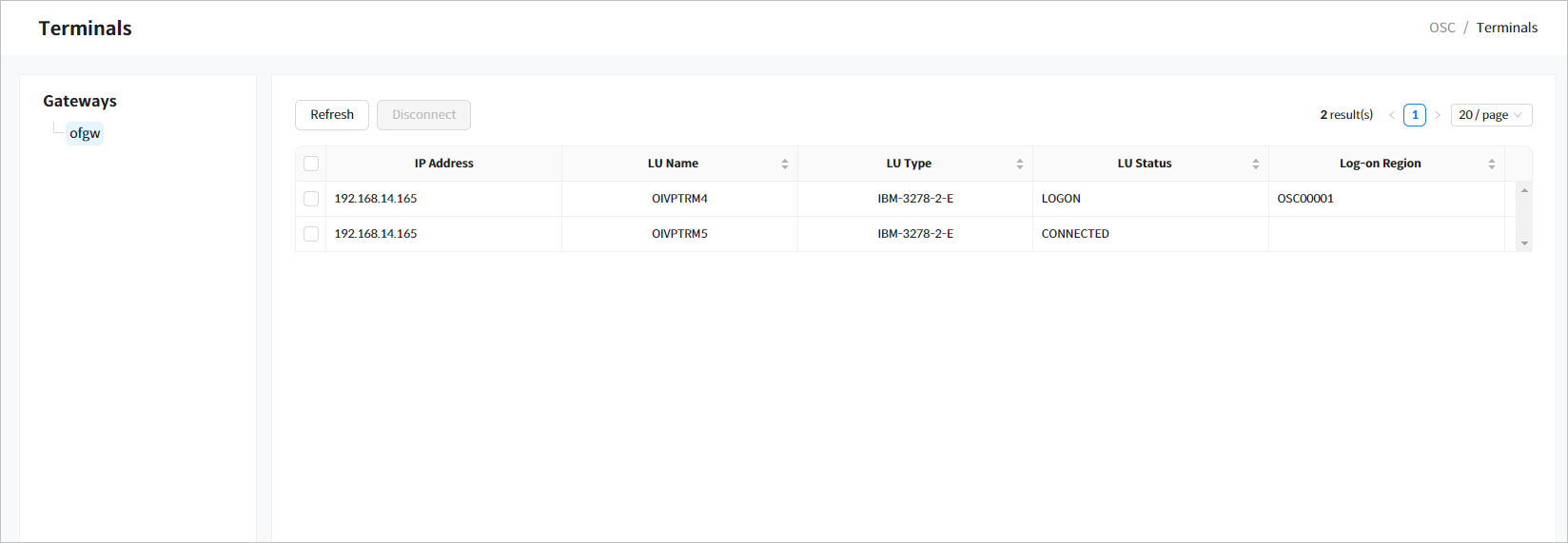
-
Search Results
The following describes the search result columns.
Column Description IP Address
IP address of the terminal.
LU Name
LU name of the terminal.
LU Type
LU type of the terminal.
LU Status
Terminal status.
-
CONNECTED: connected.
-
LOGON: connected and logged on to a region.
Log-on Region
Name of the region the terminal is currently logged on to.
-
4. Scheduled Transactions
Click [Scheduled Transactions] from the navigation pane to display transactions in the following tabs.
-
[Start Queue] Tab
-
[Delay Queue] Tab
4.1. [Start Queue] Tab
Click [Start Queue] tab to display a list of transactions that have been scheduled for execution using the START command. START command schedules a task to run at the specified time.
Enter the search conditions, and then click [Search] to display the results. If no conditions are specified, all scheduled transactions are displayed. Click [Refresh] above the list to refresh the list. Click [Cancel] to cancel the requested START command.

-
Search Conditions
The following describes the search conditions.
Item Description Region Name
Name of the region where the transaction starts in (Exact search method).
Request ID
Request ID (Exact search method).
Start Date/Time
Search returns tasks that were queued after this date/time (Exact search method).
Transaction Name
Transaction name (Exact search method).
Terminal ID
Terminal ID that initiated the transaction (Exact search method).
-
Search Results
The following describes the search result columns. A list of servers with scheduled tasks are displayed.
Column Description Region
Name of the region where the transaction will start in.
Request ID
Request ID.
Start Date/Time
Date/time when the task starts.
Transaction ID
Transaction ID.
Terminal ID
Terminal ID that initiated the transaction.
User ID
User ID that initiated the transaction.
Remote Transaction ID
Transaction ID in the remote system (this is returned when RETRIEVE command is executed while the transaction is running).
Remote Terminal ID
Terminal ID in the remote system (this is returned when RETRIEVE command is executed while the transaction is running).
Queue ID
Queue ID to use for the START request.
|
For more information, refer to "3.3.6. START" in OpenFrame OSC Developer’s Guide. |
4.2. [Delay Queue] Tab
Click [Delay Queue] tab to display a list of scheduled transactions that have been delayed from execution using the DELAY command. DELAY command delays a scheduled task from running until the specified time.
Enter the search conditions, and then click [Search] to display the results. If no conditions are specified, all delayed transactions are displayed. Click [Refresh] above the list to refresh the list. Click [Cancel] to cancel the requested DELAY command.

-
Search Conditions
The following describes the search conditions.
Item Description Region Name
Name of the region where the transaction is delayed in (Exact search method).
Request ID
Request ID (Exact search method).
Start Date/Time
Search returns tasks that were queued after this date/time (Exact search method).
-
Search Results
The following describes the search result columns. A list of servers with delayed tasks are displayed.
Column Description Region
Name of the region where the transaction is delayed in.
Request ID
Request ID.
Start Date/Time
Time when the task will be started after the delay.
|
For more information, refer to "3.3.3. DELAY" in OpenFrame OSC Developer’s Guide. |
5. Named Counters
Click [Named Counters] from the navigation pane to display a list of named counters.
Enter the search conditions, and then click [Search] to display the results. If no conditions are specified, all named counters are displayed. Click [Refresh] above the list to refresh the list.
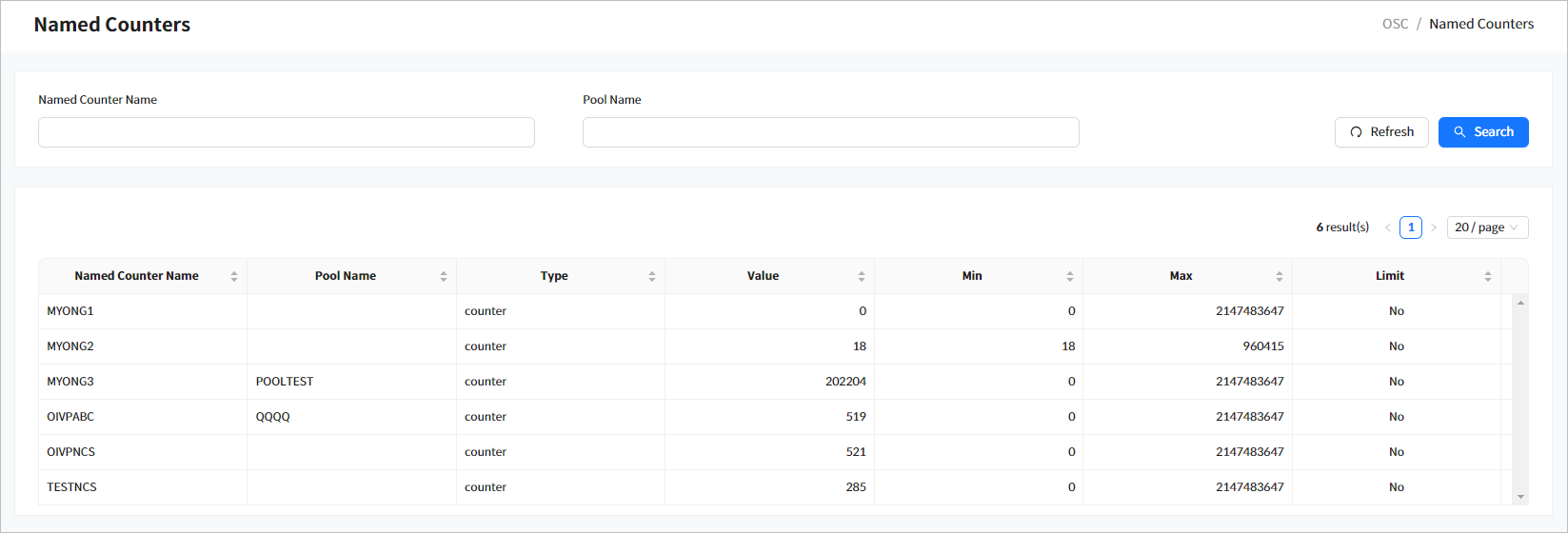
-
Search Conditions
The following describes the named counter search conditions.
Item Description Named Counter Name
Named counter name.
Pool Name
Pool name.
-
Search Results
The following describes the search result columns.
Column Description Named Counter Name
Counter name.
Pool Name
Pool name that the counter belongs to.
Type
Counter type.
-
counter: counter values are 4 byte fullword signed binary values.
-
dcounter: counter values are 8 byte doubleword unsigned binary values.
Note that each counter type can only be accessed using the corresponding counter command.
Value
Current counter value.
Min
Minimum counter value.
Max
Maximum counter value.
Limit
Specifies whether the counter has reached the maximum value.
-
6. EIB Response Codes
Click [EIB Response Codes] from the navigation pane to display a list of response codes for CICS commands.
Enter the search conditions, and then click [Search] to display the results. If no conditions are specified, all response codes are displayed (LIKE (prefix) search method).
Click [Refresh] above the list to refresh the list.
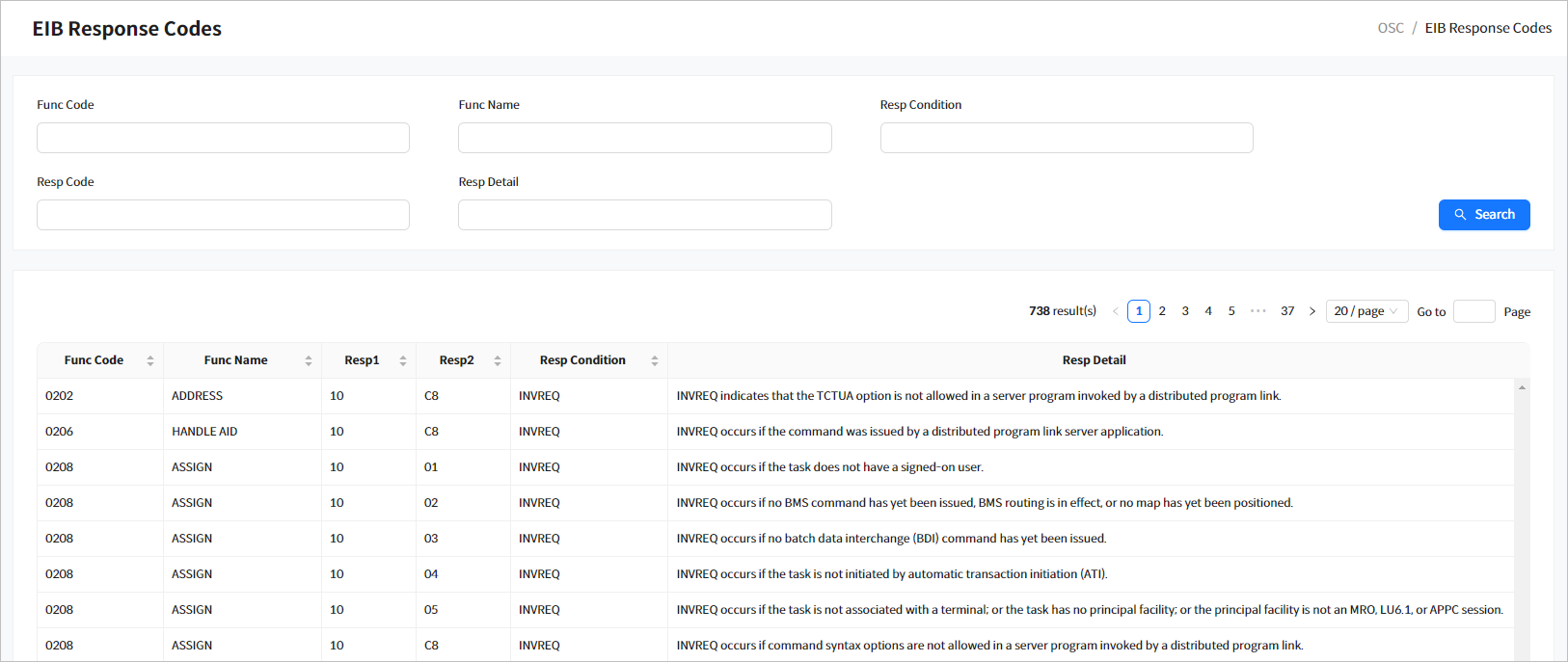
-
Search Conditions
The following describes the EIB response code search conditions.
Item Description Func Code
Command code.
Func Name
Command name.
Resp Condition
Response condition.
Resp Code
Response code. Both Resp Code1 and Resp Code2 values can be retrieved.
Resp Detail
Description for each response code.
-
Search Results
The following describes the search result columns.
Column Description Func Code
Command code.
Func Name
Command name.
Resp Code1
Primary response code.
Resp Code2
Secondary response code.
Resp Condition
Response condition.
Resp Detail
Description of the response.
|
The information shown in the result table is same as those in the eibresp.json file that can be found in the {$OFMANAGER_HOME}/resources/json/ directory. |
7. Program Deploy
Click [Program Deploy] from the navigation pane to view, add, delete, or deploy programs by region. A program is deployed to a selected region server through the osctdlupdate tool. A user with administrator privilege can manage and dynamically deploy online user programs to each region server.
Only accounts with SPECIAL privilege or specified in the OM.PGMADMIN profile of the OFMANAGER class in TACF can use [Add], [Import], [Edit], and [Delete] to view, add, edit, and delete programs. All other accounts can only use [Deploy]; however, any account can use all the buttons if the profile does not exist.
|
For more information about privileges to access each resource, refer to Chapter "5. General Resources" in OpenFrame TACF Administrator’s Guide. For more information about how to add a resource, refer to Adding a General Resource. |
You can allocate a program to a region by using [Add] or [Import], and then dynamically deploy the program to registered region servers.
Click [Deploy] to deploy a program to a selected region and display the result in 'Deployment Result'. When the result is 'success', it means that the program was successfully deployed in the selected region. When the result is 'fail', it means that the program was not deployed (Failed to copy) or the selected region is not connected (Failed to connect to this region). Displayed programs are located in the path set in the 'DEPLOY_SOURCE_PATH' item under the OSCOSSVR section in the osc subject of the openframe_osc.conf file in OpenFrame OSC. Deploying the program copies it to the TDLDIR directory managed by OSC and executes osctdlupdate.
|
For more information about the openframe_osc.conf file, refer to OpenFrame Configuration Guide. |
Enter the search conditions and then click [Search] to display the results. If no conditions are specified, all programs are displayed (Wildcard (*) search method, However, the search like A*C is not allowed). Click [Refresh] to refresh the list.

-
Search Conditions
The following describes the program search conditions.
Item Description Program Name
Program name to deploy.
-
Search Results
The following describes the search result columns.
Column Description Program Name
Program name.
Region Name
Region server name to which a program will be deployed. Multiple regions can be displayed.
Deployment Result
Most recent deployment result.
Last Deployed Date/Time
Most recent deployment date and time.
Search results are data in a database table managed by OpenFrame Manger. If a program is deployed by using the osctdlupdate tool, not OpenFrame Manger, the program cannot be searched.
7.1. Adding a Program
Click [Add] from the Program Deploy page ([OSC] - Program Deploy) to add a new program. Enter the required fields and then click [Add].
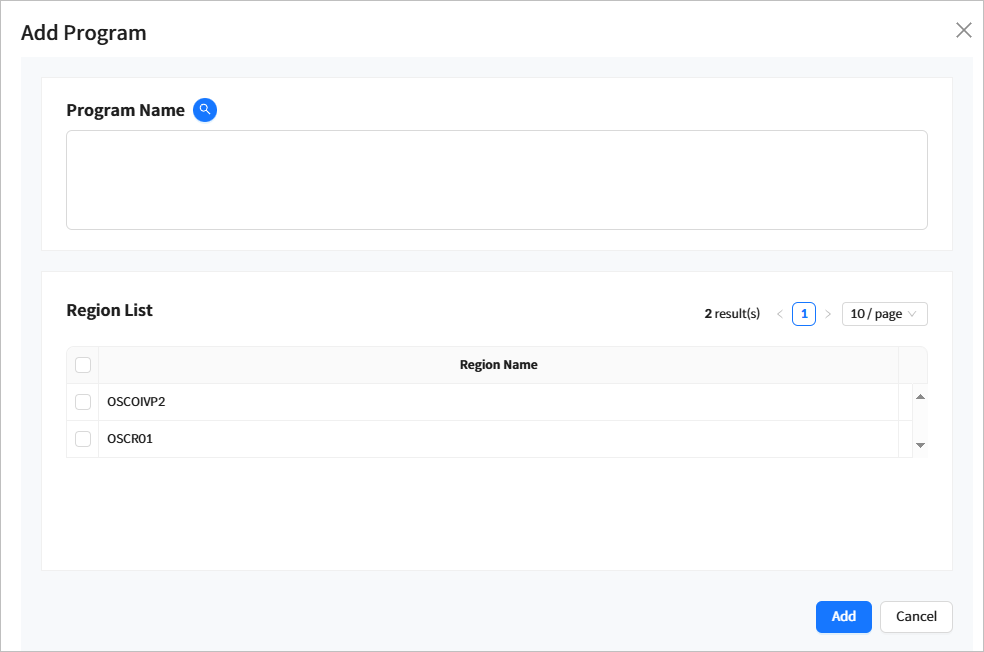
The following describes each item.
| Item | Description |
|---|---|
Program Name |
Program name. Up to 30 characters allowed (special characters allowed). Multiple names can be entered by using a comma (,) as a delimiter. For so module programs, enter only a program name. For asmo module programs, enter both a program name and an extension. Click the magnifier button on the right side to select a program on Add Program List ([OSC] - Program Deploy - Add Program List). |
Region List |
Region names to deploy a program to. A region can be added by selecting it. |
The following page shows the list of programs set in the DEPLOY_SOURCE_PATH item under the OSCOSSVR section of osc.conf. To search for a program, enter the name in 'Program Name' and click ![]() ([Search]). To select a program, select the checkbox next to the program and then click [OK].
([Search]). To select a program, select the checkbox next to the program and then click [OK].
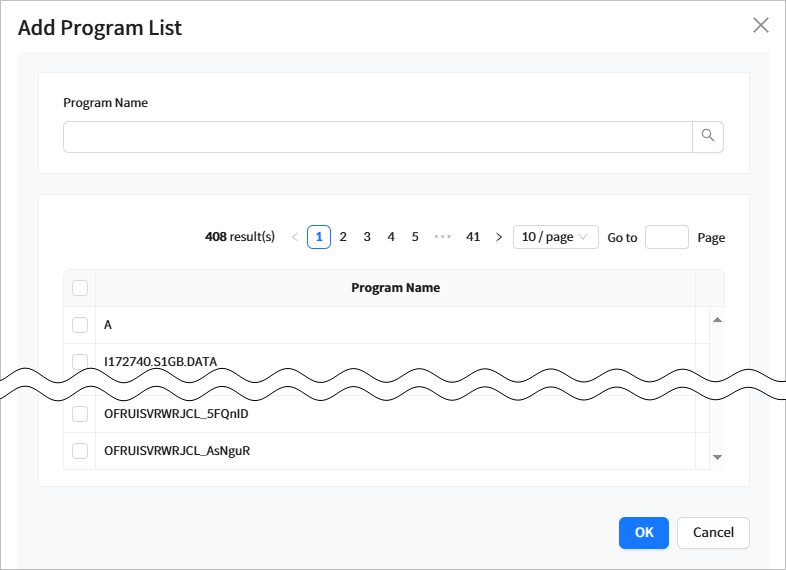
7.2. Editing a Program
Click [Edit] from the Program Deploy page ([OSC] - Program Deploy) to edit a region list of the program.
To edit a program, enter the required fields and then click [Edit]. For information about each item, refer to Adding a Program.
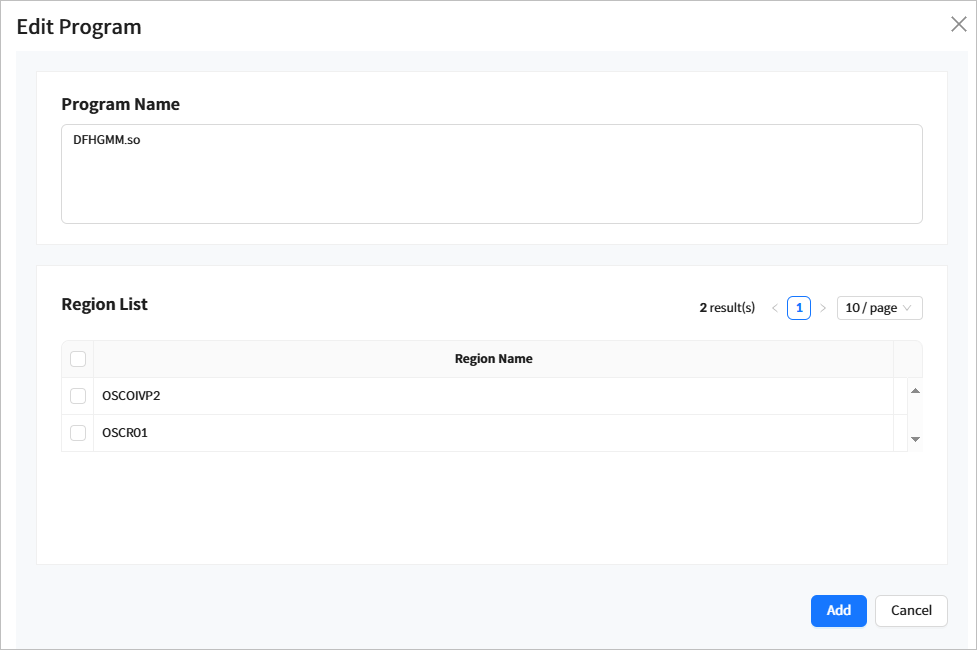
8. TX Time Control
You can use the TX Time Control menu to test the entire OSC system or specific user programs at a specific time. The following sections describe a submenu.
8.1. Time Information
Click [TX Time Control] > [Time Information] from the navigation pane to set a desired date and time for the entire OSC system or specific regions or programs.
The following is the Time Information page.

-
Search Condition
The following describes the search conditions.
Item Description Control Type
Control type to search for.
Key ID
Key ID to search for.
-
Search Results
The following describes the search result columns.
Column Description Control Type
Type of KEY_ID that sets user date and time.
-
Transaction (TX)
-
Terminal (TM)
-
User (UR)
-
Region (RG)
Key ID
ID of the location where the user specified date and time. One '*' is available to specify the ID range.
User-Set Date
User-specified date in the format of YYYY-MM-DD.
Time Type
Type of user-specified time.
-
Absolute (A): Use user-specified time.
-
Minus (M): Use the time before user-specified time based on system time.
-
Plus (P): Use the time after use-specified time based on system time.
User-Set Time
Use-specified time in the format of hh:mm:ss.
Last Register User
Name of a user who last registered data.
Last Register Time
Last time data was registered, in the format of YYYY-MM-DD hh:mm:ss.
Last Update User
Name of a user who last updated data.
Last Update Time
Last time data was updated, in the format of YYYY-MM-DD hh:mm:ss.
-
8.1.1. Add Time Information
To set OSC system time, click [Add] in the Time Information page ([OSC] - TX Time Control - Time Information). Enter the required fields, and then click [Add].

The following describes each item.
| Item | Description |
|---|---|
Control Type |
Type of KEY_ID that sets user date and time. (Required)
The priorities are as follows (from high to low): Transaction, Terminal, User, Region. |
Key ID |
ID of the location where the user specified date and time. One '*' is available to specify the ID range. |
Time Type |
Type of time to set.
|
Date |
Date to set in the format of YYYY-MM-DD. |
Time |
Time to set in the format of hh:mm:ss. |
8.1.2. Edit Time Information
To edit date and time that are set, click [Edit] in the Time Information page ([OSC] - TX Time Control - Time Information). Edit desired fields, and then click [Save]. For information about each field, refer to descriptions in Add Time Information.

8.1.3. Delete Time Information
To delete date and time that are set, select a checkbox next to a row to delete and then click [Delete] in the Time Information page ([OSC] - TX Time Control - Time Information).